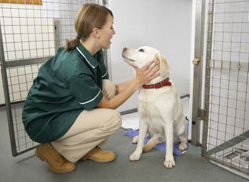In a surgical procedure requiring general anesthesia, the patient is put in a state of reversible unconsciousness. During this unconscious state, there is muscular relaxation and a complete loss of pain sensation. Once your pet is in a deep enough sleep, this allows for our doctors to complete the procedure without concern that your pet is feeling any discomfort.
Like any medical procedure, anesthesia does have risks. These risks can run from minor problems, such as mild vomiting after recovery from anesthesia, to life-threatening problems such as cardiac arrest or stroke. Anesthesia-related deaths are rare though. It is estimated that 1 in every 2000 healthy pets have an adverse reaction to anesthesia. While complications can occur, our veterinary team will take all of the necessary precautions to ensure that your pet is safe.
Before any patient is put under general anesthesia, a weight is obtained and a thorough physical examination is performed. The physical examination typically includes blood work that reviews your pet’s blood chemistry, complete blood count and electrolyte balance. This helps to ensure that their overall health is good and that there aren’t any underlying issues that can create complications during anesthesia (ex. Anemia, liver disease, kidney disease, dehydration, etc.).
Once the physical exam and bloodwork is complete, your pet is given a mild sedative in the form of an injection in the muscle or directly in the vein. An intravenous catheter is also usually placed to allow administration of fluids and medications. When ready, administration of anesthesia is delivered through intravenous infusion and gas inhalation through an endotracheal tube.
While under anesthesia, your pet will receive monitoring and care similar to what you’d receive if you underwent anesthesia. This includes constant monitoring from a dedicated and highly trained veterinary technician along with several multiparameter monitoring machines. Our technicians will continually assess your pet’s heart and respiratory rate, blood pressure, oxygen level, temperature and other vital signs to help prevent any anesthetic risk.
Once the procedure is completed, the anesthetic machine is turned off and oxygen is delivered to your pet until they are awake enough to be transferred to a kennel or cage to complete their recovery. Pets are provided with warm blankets and are closely monitored during this time to ensure they are recovering normally. Depending on your pet, pick up is usually scheduled for the same day but later in the afternoon as most of our procedures occur in the morning. Any discharge instructions or medications will also be explained by our veterinary team at time of discharge.
If you have any questions or concerns about your pet receiving general anesthesia or about the procedure for which your pet is scheduled, please contact us through email or at 416-291-2364.

